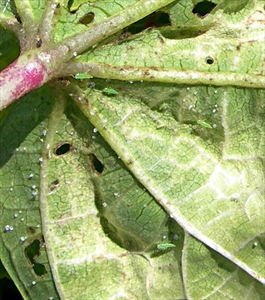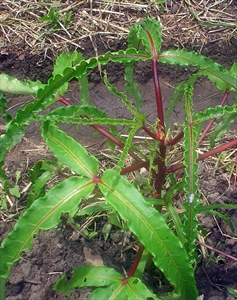Green or Indian cotton jassid (or leafhopper). These are the common names given to Amrasca devastans, but the species in the Pacific has not been identified.
Pacific Pests, Pathogens, Weeds & Pesticides - Online edition
Pacific Pests, Pathogens, Weeds & Pesticides
Bele (Abelmoschus) leafhoppers (039)
Most likely Amrasca biguttula biguttula; previously, it was known as Amrasca devastans, and Empoasca devastans.
Asia, Africa (restricted), Oceania. It is recorded from Australia, Guam, Papua New Guinea and Solomon Islands (but note, some records need verification).
Bele (aibika, island cabbage or sliperi kabis, Abelmoschus manihot), okra, cotton. It is also reported as a pest of food legumes, eggplant and peanut. In Solomon Islands, it has only been reported as a pest of bele.
The jassids (Photos 1&2) cause patches of yellow on the leaves, and some leaves turn white at the edges. They also cause the leaves to develop surface creases or wrinkles (Photo 3). Overall, they look unhealthy.
Eggs are laid in the leaves and the leaf stalks. The egg hatch in 8-10 days, and the yellow-green nymphs look similar to the adults except in size, and the fact that they are wingless. They moult four times before they become mature in 12-20 days; they are then about 2 mm long. Both nymphs and adults are wedge-shaped, and occur on the underside of the leaves. The adults vary in colour from yellowish-green to yellow, and they live for about 10 days.
Jassid populations are influenced by rainfall. High rainfall causes many deaths of nymphs and adults.
The damage caused by the jassid is often severe. In Solomon Islands, the number of insects per leaf is small in relation to the damage, so it is possible that the jassids inject a toxin as they feed. In Papua New Guinea, large numbers occur on the leaves and cause the leaves to dry up, beginning at the leaf margins, and die prematurely, especially during times of low rainfall. The damage reduces the photosynthetic ability of the leaves, the number of leaves available for consumption, and may also reduce their nutritional content, although this has not been tested.
Look at the leaves and see if they have light yellow to white patches. Look at the underside of the leaf and find the jassids. There may not be many present on each leaf. The leaves may be more crinkled than normal, but remember that leaves of some varieties of bele are naturally crinkled, even when healthy. It is easier to see the jassids if dark paper is put beneath the leaves to catch the jassids when the leaves are shaken or given a sharp tap.
NATURAL ENEMIES
A number of natural enemies of jassids have been reported worldwide. The larvae of ladybird beetles and lacewings, spiders and other predators attack both adults and nymphs. Tiny wasps are also reported that lay their eggs in those of the jasssids. The bacterium, Bacillus thuringiensis var. kurstaki, has been recorded infecting nymphs and adults. Whether or not these or other natural enemies are present in the Pacific islands, and attack jassids in the same way, is not known.
RESISTANT VARIETIES
One variety from the Western Province, Solomon Islands, appears to have resistance to jassids, although this has not been tested thoroughly. It may be an introduction from Papua New Guinea. The leaves are deeply dissected into long narrow leaflets, with a waxy green surface and dark leaf stalks; the plant is tall and narrow (Photos 4&5).
CHEMICAL CONTROL
Use insecticides that have fast action and low residual effect, that is, they break down quickly. The aim is to do the least harm to the natural enemies. Do the following:
- Use plant-derived products, such as neem, derris, pyrethrum or chilli (with the addition of soap). (See Fact Sheet no. 56).
- Alternatively, synthetic pyrethroids are likely to be effective, but will also kill natural enemies.
--------------------
Note,
derris (Derris species) contains rotenone, an insecticide, often used as a fish poison; it should be used with caution. The commercial derris insecticide is made from Derris elliptica).
____________________
When using a pesticide, always wear protective clothing and follow the instructions on the product label, such as dosage, timing of application, and pre-harvest interval. Recommendations will vary with the crop and system of cultivation. Expert advice on the most appropriate pesticides to use should always be sought from local agricultural authorities.
AUTHORS Helen Tsatsia & Grahame Jackson
Information from Bellis G, Fletcher M (2005) Indian cotton leafhopper (Amrasca biguttula biguttula): PaDIL - http://www.padil.gov.au; and from Amrasca biguttula. Wikipedia. (https://en.wikipedia.org/wiki/Amrasca_biguttula). Photo 2 Graham Teakle, Canberra.
Produced with support from the Australian Centre for International Agricultural Research under project PC/2010/090: Strengthening integrated crop management research in the Pacific Islands in support of sustainable intensification of high-value crop production, implemented by the University of Queensland and the Secretariat of the Pacific Community.








